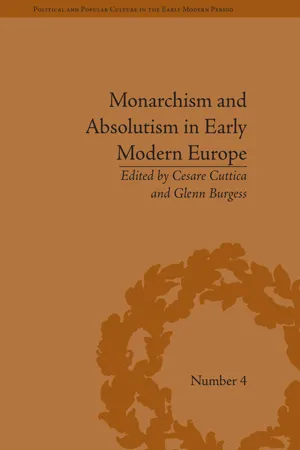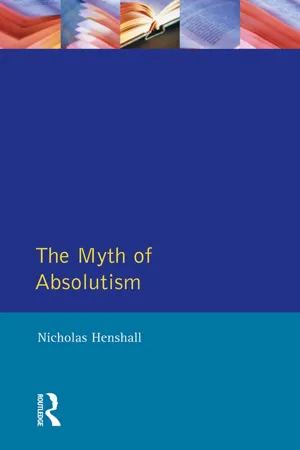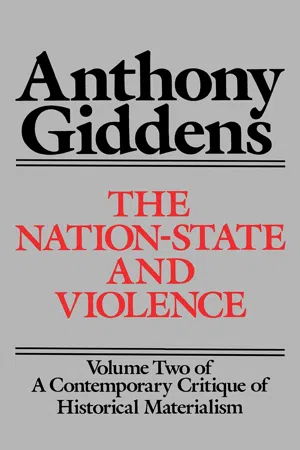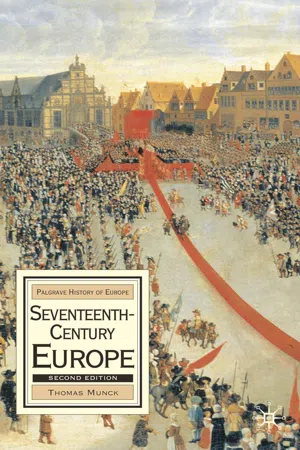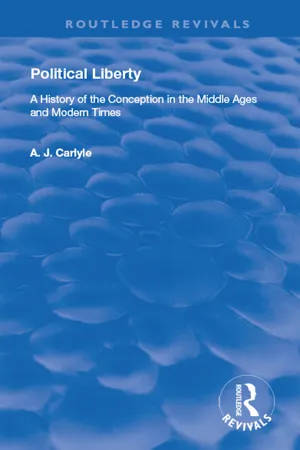History
Royal Absolutism
Royal absolutism refers to a system of government where the monarch holds absolute power and authority, often justified by the divine right of kings. This form of governance was prominent in Europe during the 17th and 18th centuries, with rulers such as Louis XIV of France exemplifying its principles. Royal absolutism centralized power in the hands of the monarch, diminishing the influence of nobles and other governing bodies.
Written by Perlego with AI-assistance
Related key terms
Related key terms
1 of 4
Related key terms
1 of 3
7 Key excerpts on "Royal Absolutism"
- eBook - ePub
- Cesare Cuttica, Glenn Burgess, Cesare Cuttica, Glenn Burgess(Authors)
- 2015(Publication Date)
- Routledge(Publisher)
29Confronted by this cauldron of divergent interpretations, the historian aims to tease out the presence and status of some recurrent conceptual features. Accordingly, to facilitate our task we might start with Johann Sommerville’s definition of absolutism as a theory arguing that ‘the ruler in any state holds sovereign authority, cannot be actively resisted, can change existing constitutional arrangements in a case of necessity (though he ought otherwise to maintain them), and should be obeyed by his subjects provided that his commands are not contrary to those of God and nature’.30 This, however, is essentially a definition of a theory of sovereignty . The chapters below suggest that there is a contextual element as well, that theories historians are willing to label ‘absolutist’ usually functioned in particular contexts as attempts to elevate the (personal) authority of a monarch over other institutions. In that sense, a theory of absolutism is the application of a theory of sovereignty to the institution of monarchy, and can be distinguished from more impersonal theories of state sovereignty (though the two can be combined).III
This volume is structured in a thematic way. Each section focuses on a few major interpretative categories in order to give a complex and innovative picture of the multiple threads informing absolutist and monarchist political discourse across Europe between the late Middle Ages and the Enlightenment. This method should help to untangle the richness of topics and the complexity of meanings emerging from the works analysed. In this respect, we hope to have provided new coordinates with which to map out the territory of early modern absolutism. Through its chronological frame, our collection suggests patterns of both change and continuity informing the paradigm of absolute monarchical power and its interactions with government across Europe. - No longer available |Learn more
The Modernization of the Western World
A Society Transformed
- John McGrath, Kathleen Callanan Martin(Authors)
- 2017(Publication Date)
- Routledge(Publisher)
9 The Centralization and Rationalization of the Political StateJohn McGrathKey Terms
absolutism, “balance of power,” bullionism, constitutional monarchy, “Divine Right,” economy of scale, federated republic, infrastructure, mercantilism, separation of powers, “tax farmers”While long-term economic and social forces helped to redefine the role of government during the Early Modern Period, more immediate circumstances also spurred political change, reinforcing the movement toward more concentrated forms of authority. During the Reformation era, religious divisions within and among European states, often intensified by ethnic, social, and economic differences, challenged even the most powerful monarchs to keep a firm grip on their subjects. This gave many European rulers another reason to increase the size, power, and efficiency of their administrations. The result was a new form and style of political organization known as absolutism.1 Typically, absolutism “introduced standing armies, a permanent bureaucracy, national taxation, a codified law, and the beginnings of a unified market.”2 Together, these elements rationalized and centralized political authority, representing a significant step in the modernization of the political state.These new structures and policies were justified on the basis of new ideologies that marked a distinct shift from the traditional medieval concept of authority. In contrast to the largely decentralized feudal system where successive levels of nobility ruled in accordance with local customs and practices, absolutist monarchies began to enjoy, at least in theory, total and absolute power over all their subjects. Such power was often supported by the religious concept of “Divine Right - eBook - ePub
The Myth of Absolutism
Change & Continuity in Early Modern European Monarchy
- Nicholas Henshall(Author)
- 2014(Publication Date)
- Routledge(Publisher)
CHAPTER SIXA Theory of Absolutism?
Most critics of ‘absolutism’ as a concept have focused on the practice of governments. They have exposed the extent to which rulers failed to achieve their programmes. But the theory of ‘absolutism’ has been assumed rather than examined. The question is whether such a theory existed in early modern times. We start with the three ruler classifications used in early modern Europe – monarch, republic and despot. Then we shall see if we require another to make sense of the story.PROBLEMS OF EVIDENCE
Forms of government were regulated by a constitution, which laid down the distribution, procedures and limits of public power. Constitutions were usually customary, resulting from tacit agreement by the community about the best way of satisfying its collective needs. They might include written items, such as the English constitution’s Magna Carta and Declaration of Rights, but their weight rested on the acceptance of a customary way of doing things. Nineteenth-century European Liberals considered customary constitutions to be no constitutions at all, since they had benefited from what they considered the superior arrangements of the late eighteenth century -getting fundamentals on paper.The lack of written constitutions before the 1770s has an important consequence for historians. A definitive statement about the source and limits of power was beyond the capacities of contemporaries. Controversy rumbled at the time and subequently. Before we enter the fray, let us be clear that the Bourbon constitution had little objective existence. It was merely the sum total of what people said and thought about it at the time. Nor did the monarchs of seventeenth-century France ever make an official statement about the extent and nature of their power. A few one-liners are attributed to Louis XIV, including the notorious ‘L’état, c’est moi’ – which can be made to fit any theory of Bourbon power that one chooses. His motto was nec pluribus impar , which is Versailles-speak for ‘I’m the greatest’. It scarcely amounts to a political theory. He also wrote his Memoirs - eBook - ePub
- Anthony Giddens(Author)
- 2013(Publication Date)
- Polity(Publisher)
18 What is important in judging the novelty of the absolutist state is not just to measure it against feudalism, as generations of historians have done, but to contrast it to other forms of traditional state in general. The absolutist state is still, in my terms, a traditional state. That is to say, in some of its main characteristics it remains a class-divided society. But in other respects it has features barely found at all elsewhere.These are not easily distinguished if one supposes, as some have done, that absolutism is a sort of Oriental Despotism writ small. Not only does such an analysis repeat the error of holding that centralized bureaucratic empires were much more cohesive than actually was the case, it fails to give sufficient weight to certain distinctive aspects of the rule (and the claims to legitimacy) of the European monarchs. These largely centre upon both the notion and the actuality of sovereignty.19 Rulers in traditional states were always in a certain sense ‘sovereigns’: they were acknowledged (at least by those lower in the state apparatus) to be the supreme authority in the political order. Like the absolutist monarchs, they claimed legitimacy by reference to sacred symbols; the notion of ‘divine right’ to rule in its core meaning is hardly a European innovation, whatever its specific form might indicate. But traditional rulers elsewhere had not, as it were, incorporated the state within their own person; they sat at the pinnacle of it. The religious symbolism of ‘divine right’ should actually be seen as a traditional accoutrement to something very new – the development of ‘government’ in the modern sense, the figure of the ruler being a personalized expression of a secularized administrative entity.The progressive shaping of the concept of ‘sovereignty’ in the hands of political thinkers from the fifteenth to the end of the seventeenth century is instructive in this regard. ‘Sovereign’ suggests an etymological connection with the idea of an individual ruler but such is not its main origin, which helps explain why it was easily transferred into an impersonal form of ‘sovereignty’. Prior to Bodin, the term ‘sovereign’ had been applied as an adjective in an imprecise way to any individual of rank. In the fifteenth and sixteenth centuries in England, even a relatively minor personage such as a mitred abbot was officially referred to as a sovereign but only because he stood at the head of an ecclesiastical organization. The word was more usually employed to refer to characteristics of organizations themselves – three sovereign courts of law were recognized in France, for example.20 In asserting (with some reservations) that there can be only one sovereign, Bodin was not simply asserting the transcendent authority of the individual monarch, he was describing and advocating a co-ordinated system of administrative rule.21 It can justifiably be claimed, I think, that neither the fact of a non-monarchical regime, nor the various theories of republicanism and libertarianism associated with the English Revolution could have come about without the prior establishing of a ‘discourse of sovereignty’.22 - eBook - ePub
The Emergence of Modern Europe
c. 1500 to 1788
- Britannica Educational Publishing, Heather Campbell(Authors)
- 2010(Publication Date)
- Britannica Educational Publishing(Publisher)
intendants (administrative officials), first used extensively by Richelieu, then, after their abolition during the Fronde, more systematically and with ever-widening responsibilities, by Louis XIV and his successors until 1789.Louis XIV (b. Sept. 5, 1638, Saint-Germain-en-Laye, France—d. Sept. 1, 1715, Versailles)The king of France from 1643 to 1715, Louis XIV ruled during one of France’s most brilliant periods. Known as the Sun King, he remains the preeminent symbol of absolute monarchy. He succeeded his father, Louis XIII, at age four, under the regency of his mother, Anne of Austria. In 1648 the nobles and the Paris Parlement, who hated the prime minister, Cardinal Mazarin, rose against the crown and started the Fronde revolt. In 1653, victorious over the rebels, Mazarin gained absolute power, though the king was of age. In 1660 Louis married Marie-Thérèse of Austria (1638–83), daughter of Philip IV of Spain. When Mazarin died in 1661, Louis astonished his ministers by informing them that he intended to assume responsibility for ruling the kingdom. A believer in dictatorship by divine right, he viewed himself as God’s representative on earth. He was assisted by his able ministers, Jean-Baptiste Colbert and the marquis de Louvois. Louis weakened the nobles’ power by making them dependent on the crown. A patron of the arts, he protected writers and devoted himself to building splendid palaces, including the extravagant Versailles, where he kept most of the nobility under his watchful eye. In 1667 he invaded the Spanish Netherlands in the War of Devolution (1667–68) and again in 1672 in the Third Dutch War. The Sun King was at his zenith; he had extended France’s northern and eastern borders and was adored at his court. In 1680 a scandal involving his mistress, the marchioness de Montespan (1641–1707), made him fearful for his reputation, and he openly renounced pleasure. The queen died in 1683, and he secretly married the pious marchioness de Maintenon. After trying to convert French Protestants by force, he revoked the Edict of Nantes in 1685. Fear of his expansionism led to alliances against France during the War of the Grand Alliance (1688–97) and the War of the Spanish Succession (1701–14). Louis died at age 77 at the end of the longest reign in European history. - eBook - ePub
Seventeenth-Century Europe
State, Conflict and Social Order in Europe 1598-1700
- Thomas Munck(Author)
- 2017(Publication Date)
- Bloomsbury Academic(Publisher)
Absolute monarchy and the return of order after 1660The later seventeenth century may be regarded as the period when absolute monarchy reached its classic form – a monarchy unlimited in law, seeking to project the King as an unchallengeable (even divinely ordained) judge and prince, underpinned by an administrative machinery whereby the daily exercise of power from the centre would become an accepted fact. This became in effect the ‘normal’ type of government in Europe for the next century or more. Yet, perhaps because the notion of monarchy was itself meant to be something of a divine mystery, there are relatively few formal statements of constitutional law from this period which can help clarify what precisely was intended. An unambiguous text is that of the substantial law code promulgated in Denmark in 1683, Danske Lov , whose very first article made clear that the monarch:alone has supreme authority to draw up laws and ordinances according to his will and pleasure, and to elaborate, change, extend, delimit and even entirely annul laws previously promulgated by himself or his ancestors. He can likewise exempt from the letter of the law whatsoever or whomso-ever he wishes. He alone has supreme power and authority to appoint or dismiss at will all officials regardless of their rank, name or title; thus offices and functions of all kinds must derive their authority from the absolute power of the King. He has sole supreme authority over the entire clergy, from the highest to the lowest, in order to regulate church functions and divine service. He orders or prohibits as he sees fit all meetings and assemblies on religious affairs, in accordance with the word of God and the Augsburg Confession. He alone has the right to arm his subjects, to conduct war, and to conclude or abrogate alliances with whomever he wishes at any time. He can impose customs dues and taxes as he wishes. In short, the King alone has the power to use all jura majestatis - eBook - ePub
Political Liberty
A History of the Conception in the Middle Ages and Modern Times
- A. J. Carlyle(Author)
- 2019(Publication Date)
- Routledge(Publisher)
PART IITHE CONCEPTION OF POLITICAL LIBERTY IN THE SEVENTEENTH CENTURY I THE DEVELOPMENT OF THE THEORY OF ABSOLUTISM IN THE SIXTEENTH AND SEVENTEENTH CENTURIESW E have pointed out, in the preceding chapter, that, while the forms of political society in the Middle Ages were very different from those of to-day, the principles of political liberty were very highly developed, especially under the terms of the supremacy of the law over the ruler, the law which was the expression not of the will of the ruler, but of the habit of life of the political community.We have now to ask how it came about that in the course of the seventeenth and eighteenth centuries, this conception was almost wholly lost over a great part of Europe, and was replaced by a theory of the absolute authority of the prince; or rather, for this work is not a constitutional history of Europe, under what terms was this somewhat irrational conception expressed?It would be absurd to attempt to find a short and adequate answer to the question why this happened, but it is possible to point out some of the elements which would find their place in such an inquiry. We may begin by observing that in one great country of Europe political liberty had in large measure perished as early as the fourteenth century. The great Italian jurist Bartolus of Sassoferrato had no illusions about a tyranny, to him it was the worst of all evil forms of government. The government by the few over the multitude was corrupt when it pursued its own good, and not that of the whole, but it was not so far removed from the common good as that of the one man who governed for his own profit, that is the tyrant, but ‘Italy is to-day full of Tyrants’.1 Two centuries later Machiavelli said that nothing could restore liberty to Milan or Naples, this could be seen in the fact that, when Filippo Maria Visconti died, Milan desired to recover its liberty, but it was impossible, for the corruption of the people had gone too far.1
Index pages curate the most relevant extracts from our library of academic textbooks. They’ve been created using an in-house natural language model (NLM), each adding context and meaning to key research topics.
Explore more topic indexes
Explore more topic indexes
1 of 6
Explore more topic indexes
1 of 4
